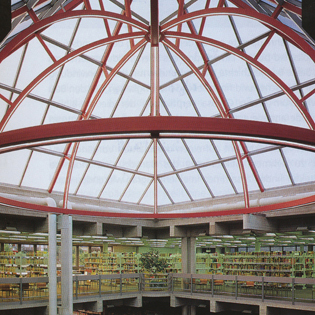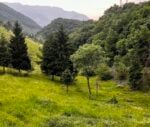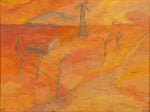Pedro Neves Marques / Andrè Romão

La Galleria Umberto Di Marino è lieta di presentare la prima personale di Pedro Neves Marques dal titolo When’s the End of Celebration? e la prima personale di André Romão dal titolo Barbarian Poems.
Comunicato stampa
La Galleria Umberto Di Marino è lieta di presentare, giovedì 6 ottobre 2011, la prima personale di Pedro Neves Marques dal titolo When’s the End of Celebration?
La contaminazione tra diversi campi scientifici caratterizza tutti i lavori dell’artista: l’individuazione del campo d’indagine, sia esso storico, sociologico ed estetico, sfugge al controllo di una rigida definizione per usare la digressione come strumento di un tentacolare sforzo di rappresentazione dei processi di soggettivizzazione, di formazione dell’individualità e di organizzazione di persone, strutture o eventi.
La definizione del proprio io in relazione con l’altro (si parli di un oggetto, una persona, una comunità o un fenomeno culturale) passa anche attraverso la difficoltà comunicativa di trasmettere la propria esperienza, cioè del condividere. In questo atto cognitivo ha sempre svolto un ruolo decisivo la scrittura, mentre il tempo, inteso come concetto e come strumento organizzativo, è un tema ricorrente. La pratica di Pedro Neves Marques, quindi, implica da sempre una narrativa all’interno del processo creativo come sottotesto al progetto espositivo, nella costruzione di un discorso svelato attraverso i rimandi selezionati. La dislocazione temporale degli stessi contenuti enunciati si concretizza, invece, in uno spostamento concettuale più che fisico, alla ricerca di nuovi possibili punti di vista per i fenomeni contemporanei.
Recentemente, infatti, l’artista si è concentrato sui modelli operativi attraverso cui avviene l’esperienza dell’altro da sé nonché la relazione tra le differenze, intendendo riflettere sulle condizioni storiche, sociali e psicologiche che li hanno determinati. Qui s’inseriscono le teorie di Frederic Jameson, che critica la tendenza postmodernista a fondere tutti i riferimenti culturali in un’unità indifferenziata da cui attingere liberamente, in quanto infiltrazione della logica economica capitalistica e multinazionale nella sfera intellettuale. Questo discorso viene poi traslato sul piano dei codici linguistici dalle considerazioni di Jean Baudrillard in merito al collasso dell’idea stessa di progresso storico e delle ideologie, causato dalla perdita del significato. Sullo sfondo di queste discussioni l’artista si chiede se, più che da una relatività post-moderna, il significato non venga attualmente conferito da un’esplosione di ibridi temporali e culturali. Più concretamente, al’interno della mostra, questa indagine viene sintetizzata nel confronto tra le specifità di edifici collocati in contesti differenti, insieme ad una serie di foto ed alcuni testi.
Il video ed il testo When’s the End of Celebration?, infatti, insiste sulle parti strutturali di uno degli edifici più riconoscibili di Lisbona come esempio di tardo postmodernismo, estrapolando dettagli da un video girato nel 1985. Tornare indietro al momento in cui questo fenomeno culturale fondava le sue premesse significa cercare le origini dell’ibrido magma culturale in cui ci troviamo immersi e di cui cominciamo ad intravedere l’etica. Così come nella serie di foto, dettagli decorativi di architetture sud-americane, le cui forme ibride influenzate dalla rappresentazione coloniale hanno forzato gli schemi di quelle europee, si mescolano con le immagini di un dipartimento di ricerca dell’Università di St. Gallen in Svizzera, il cui Dipartimento di Management, fin dagli anni ’60, ha sviluppato un modello economico influenzato dalle politiche ecologiche e del pensiero sistemico. Eclettismo ed innovazione, quindi, si rincorrono in un cerchio continuo che individua in un ibrido citazionismo la cifra, ma anche il limite, del nostro tempo.
Pedro Neves Marques (Lisbona, PT, 1984. Vive e lavora tra Lisbona, Londra e San Paolo.
Tra le principali mostre personali e collettive:
2010 Solo show (in collaboration with André Romão), Fundação EDP, Lisbon PT
On the Invisibility of Performance and the Resonance of Lives - Three Proposal Intertwined (in collaboration with Emily Verla Bovino), Etc Gallery, Prague, CZ
2008 Abridged Imagetics, Galeria Pedro Cera, Lisbon, PT
2010 HaVE A look! Have A Look!, curated by FormContent, FormContent, London, Uk
The Horizon Line is Here – tornare per partire, curated by Lorenzo Bruni, Galleria Umberto Di Marino, Napoli, Italy
2008 A river ain’t too much to love, Spike Island, UK
Eurasia, Anastácio-Gonçalves House Museum, Lisbon, PT
Ocurrence, Baginski Gallery, Lisbon, PT
2007 BesRevelation 2007, Serralves Villa – Contemporary Art Museum, Oporto, PT
Galleria Umberto Di Marino is pleased to present the first solo show in its space by Pedro Neves Marques entitled When’s the End of Celebration?, on Thursday 6th October 2011.
The contamination between different fields of knowledge is a distinctive feature of the artists’ work (writings, essays, group meetings, photographs, videos or appropriations): the identification of his field of research, whether historical, sociological or aesthetic, escapes rigid definition and uses digression as a tool for a sprawling attempt to portray the reality of subjectivation processes, the formation of individuality, and the agency of persons, structures or events.
The definition of one’s ego in relation to the other (whether it be an object, a person, a community or a cultural phenomenon) also passes through the communicative difficulty of conveying one’s own experience, that is, of a sharing. In this cognitive act, writing plays a decisive role in the artist’s practice; while conceptually time, understood as a sphere of agency, is a recurrent subject. The practice of Pedro Neves Marques has therefore always implied a narrative within the creative process or as a subtext to the exhibition layout and design, in the creation of a discourse revealed through selected references. In search of new possible standpoints for contemporary phenomena, the notion of temporal displacement of the narrated contents themselves, appears as instrumental and is achieved through a shift that is more conceptual than physical.
Recently, the artist has focused on operative models through which the experience of the other and relation between differences is managed, intending to reflect on the historical, social and psychological conditions that have created them. It is here that the theories of Fredric Jameson can be said to come into play. Jameson has criticised the post-modernist tendency to merge all cultural references into an undifferentiated unity that can be freely drawn upon, since it signals an infiltration of the capitalist and multinational economic logic within the intellectual sphere. This discourse was then transferred to the level of linguistic codes by Jean Baudrillard’s observations on the collapse of the idea of historical progress and ideologies caused by the loss of meaning. Yet, beyond such discussion, the artist inquires if, instead of a post-modern relativity, meaning is not in fact currently being produced from such explosion of temporal and cultural hybrids. More concretely, in the show such inquiry is expressed through a comparison between the specificity of two iconic post-modern buildings situated in different contexts, as well as with a group of on-going photographs and short texts.The video and text When’s the End of Celebration? dwells on the structural parts of one of the most distinctive buildings in Lisbon as an example of late post-modernism, extrapolating details from footage of the buildings’ construction in 1985. Going back to the moment when this cultural phenomenon became established involves searching for the origins of the hybrid cultural magma in which we are immersed and whose ethics are just beginning to emerge. Similarly, in the series of photos on show, decorative details of South American Baroque architecture, whose hybrid forms and colonial representation corrupted the European architectural models exported to the colonies, are mixed with images of the University of St Gallen in Switzerland, of which its Institute of Management has developed since the late 1960s an economic model influenced by the politics of ecological and systemic thinking. Eclecticism and innovation therefore chase each other in a continuous circle that identifies the key feature of our time, but also its limitation, in a hybrid tendency to quote from all possibilities.
Pedro Neves Marques Lisbon, Portugal, 1984. Lives and works ibetween Lisbon, London and São Paulo.
Selected solo and group shows:
2010 Solo show (in collaboration with André Romão), Fundação EDP, Lisbon PT
On the Invisibility of Performance and the Resonance of Lives - Three Proposal Intertwined (in collaboration with Emily Verla Bovino), Etc Gallery, Prague, CZ
2008 Abridged Imagetics, Galeria Pedro Cera, Lisbon, PT
2010 HaVE A look! Have A Look!, curated by FormContent, FormContent, London, Uk
The Horizon Line is Here – tornare per partire, curated by Lorenzo Bruni, Galleria Umberto Di Marino, Napoli, Italy
2008 A river ain’t too much to love, Spike Island, UK
Eurasia, Anastácio-Gonçalves House Museum, Lisbon, PT
Ocurrence, Baginski Gallery, Lisbon, PT
2007 BesRevelation 2007, Serralves Villa – Contemporary Art Museum, Oporto, PT
La Galleria Umberto Di Marino è lieta di presentare, giovedì 6 ottobre 2011, la prima personale di André Romão dal titolo Barbarian Poems.
L’artista pone come punto di partenza della sua pratica l’uso contemporaneo del linguaggio, attraverso differenti modalità espressive, estrapolando riferimenti culturali da epoche storiche diverse per poi rielaborarli con l’intento di sottolineare gli aspetti controversi dei codici linguistici contemporanei, di cui l’arte è parte. Come già annunciato nel titolo, la mostra presso la Galleria Umberto Di Marino prende spunto da una figura fortemente caratterizzata dal punto di vista storico: quella del barbaro. Sulla sua definizione è sempre stato aperto un vivace dibattito, che col tempo ha portato a modificare l’originaria accezione negativa a vantaggio di un giudizio più aperto a considerare gli effetti rigeneranti che l’introduzione di una nuova cultura può avere su una determinata società, sebbene attraverso un processo doloroso.
La violenza è un altro dei temi centrali dell’esposizione, come risulta dalla lettura degli undici Barbarian Poems inseriti nell’omonima installazione. Sviscerando l’argomento nella più vasta accezione dei suoi significati ed integrando sistematicamente suggestioni provenienti da diverse culture, i poemi richiamano all’attenzione la violenza simbolica in relazione al pensiero, la coercizione dei sistemi e la citazione come forma di produzione di significato. Allo stesso tempo viene così svelato quanto la volontà soggettiva applichi una forma di violenza all’interno di questa produzione. Da qui la triplice proiezione con una raccolta di diversi manufatti provenienti dalle collezioni del Museo Etnologico di Berlino, che richiama alla mente fasi archeologiche diverse: dal tardo Ellenismo (epoca barbarica per antonomasia), all’arte oceanica, al realismo sociale. Vi s’intersecano le immagini scattate nella foresta poco fuori la capitale tedesca ed i testi, in cui l’asprezza e la durezza dei termini adoperati mettono in luce anche il potere, non solo evocativo ma anche penetrante, delle parole.
Lo slittamento di senso provocato dalla rielaborazione di episodi storici, letterari ed artistici trova una sintesi omogenea nella seconda opera Notes for an history of violence, in cui su una scultura triangolare nera viene scagliato del pigmento dorato, come proseguimento delle riflessioni iniziate nei poemi, ma in assenza di parole. Una metafora, come dalle parole di André Romão, del «terreno precario esistente tra etica ed estetica, politica e poetica, storiografia e misticismo».
André Romão (Lisbona 1984). Vive e lavora a Berlino
Tra le principali mostre personali e collettive:
2011 Bosh Young Talent Show, Stedelijk Museum, ‘S-Hertogenbosch NL
Staging the archive, a cura di. Ana Anacleto, Museu de Arte Contemporânea de Elvas PT
2010 The Pavillion of Progress / The Pavilion of Fall, Galeria Baginski, Lisbona PT
The Vertical Stage, Künstlerhaus Bethanien, Berlino DE
The Winter of (our) Discontent a cura di João Mourão and Luís Silva, Kunsthalle Lissabon, Lisbona PT
Às Artes, Cidadãos! a cura di João Fernandes, Óscar Faria, Serralves Museum, Oporto PT
Res Publica a cura di Helena de Freitas, Leonor Nazaré, Fundação Calouste Gulbenkian, Lisbona PT
The horizon line is here - Tornare per partire a cura di Lorenzo Bruni, Galleria Umberto Di Marino, Napoli, IT
2009 On the Razor’s Edge (cur. Pablo Florez), Galeria Heinrich Ehrhardt, Madrid ES
Democracy among Tyrants, Galeria Pedro Cera, Lisbona PT
2008 Places for Heroes (cur. Lorenzo Bruni), Vianuova Arte Contemporanea, Firenze IT
Galleria Umberto Di Marino is pleased to present the first solo show in its space by André Romão entitled Barbarian Poems, on Thursday 6th October 2011.
As a starting assumption, we can say that the artist reflects on the contemporary use of language through different media, extrapolating cultural references from different historical periods and then reworking them with the aim of underlining the controversial aspects of contemporary linguistic codes of which art is a part. As already indicated in the title, the exhibition at the Galleria Umberto Di Marino is inspired by a figure that occupies a distinctive place in history: the barbarian. There has been a long-running debate about the definition of the term whose negative connotation has gradually given way to a judgement that is more open to considering the regenerating effects of a new culture upon a society, even though it may involve a painful process.
Violence is one of the central themes of the exhibition, as emerges from a reading of the eleven Barbarian Poems in the installation of the same name. Approaching violence in its widest field of meaning, this poems in their systematic cultural quotation, reference elliptically the symbolic violence of words over thought, the violence of systems and quotation as a form production of meaning as well as the role of subjective violence in production.
This has led to the triple projection with a collection of various objects from the collections of the Ethnological Museum in Berlin which calls to mind various archaeological phases from late Hellenism (the barbarian phase par excellence) to oceanic art and social realism. These intersect with images, taken in the forest just outside the German capital, and texts in which the bitterness and hardness of the terms used also highlight the power – not just evocative but penetrating – of words.
The displacement of meaning provoked by the reworking of historical, literary and artistic episodes finds a homogeneous synthesis in the second work Notes for an history of violence, in which gold pigment is hurled at a black triangular sculpture, as an wordless continuation of the poems. As in the words of André Romão, it is a metaphor of the “precarious terrain that exists between ethics and aesthetics, politics and poetics, historiography and mysticism”.
André Romão (Lisbon 1984). Lives and works in Berlin.
Selected solo and group shows:
2011 Bosh Young Talent Show, Stedelijk Museum, ‘S-Hertogenbosch NL
Staging the archive, curated by Ana Anacleto, Museu de Arte Contemporânea de Elvas PT
2010 The Pavillion of Progress / The Pavilion of Fall, Galeria Baginski, Lisbon PT
The Vertical Stage, Künstlerhaus Bethanien, Berlin DE
The Winter of (our) Discontent curated by João Mourão and Luís Silva, Kunsthalle Lissabon, Lisboa PT
Às Artes, Cidadãos! Curated by João Fernandes, Óscar Faria, Serralves Museum, Oporto PT
Res Publica curated by Helena de Freitas, Leonor Nazaré, Fundação Calouste Gulbenkian, Lisbon PT
The horizon line is here - Tornare per partire curated by. Lorenzo Bruni, Galleria Umberto Di Marino, Naples IT
2009 On the Razor’s Edge curated by Pablo Florez, Galeria Heinrich Ehrhardt, Madrid ES
Democracy among Tyrants, Galeria Pedro Cera, Lisbon PT
2008 Places for Heroes curated by Lorenzo Bruni, Vianuova Arte Contemporanea, Florence IT



